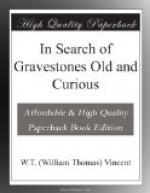The second object is to recommend to others a new and delightful hobby, and possibly bring to bear upon my theme an accumulation of knowledge and combination of light. Gravestone hunting implies long walks in rural scenes, with all the expectations, none of the risks, and few of the disappointments of other pursuits. From ten to fifteen miles may be mapped out for a fair day’s trudge, and will probably embrace from three to six parish churchyards, allowing time to inspect the church as well as its surroundings. Saturdays are best for these excursions, for then the pew-openers are dusting out the church, and the sexton is usually about, sweeping the paths or cutting the grass. The church door will in most cases be open, and you can get the guidance you want from the best possible sources. A chat with the village sexton is seldom uninviting, and he can generally point out everything worth your observation. But the faculty of finding that of which you are in search will soon come to you. In the first place, the new portion of a churchyard—there is nearly always a new portion—may be left on one side. You will certainly find no ancient memorials there. In the next place, you may by a little observation pick out the eighteenth-century stones by their shape, which is as a rule much more ornamented and curvilinear than those of later date. They may also be detected very often by the roughness of their backs as well as by their weather-beaten complexions, and with a little experience and practice the student may guess correctly within a few years the age of any particular one seen even in the distance.
[Illustration: Fig. 62. GEEENFORD.]
[Illustration: Fig. 63. West Ham.]
To tempt the reader therefore to take up the study which I have found so pleasant, so healthful, and so interesting, I now propose to place in order the proceeds of a few of my rambles, and shew how much success the reader may also expect in similar expeditions. His or her stock-in-trade should consist of a good-sized note-book or sketch-book of paper not too rough for fine lines, a B B pencil of reliable quality, and a small piece of sandstone or brick to be used in rubbing off the dirt and moss which sometimes obscure inscriptions. No kind of scraper should ever be employed, lest the crumbling memorial be damaged; but a bit of brick or soft stone will do no harm, and will often bring to view letters and figures which have apparently quite disappeared. If a camera be taken, a carpenter’s pencil may be of service in strengthening half-vanished lines, and a folded foot-rule should always be in the pocket. A mariner’s compass is sometimes useful in strange places, but the eastward position of a church will always give the bearings, and a native is usually to be found to point the way. A road map of the county which you are about to explore, or, if in the vicinity of London, one of those admirable and well-known handbooks of the field paths, is useful,




